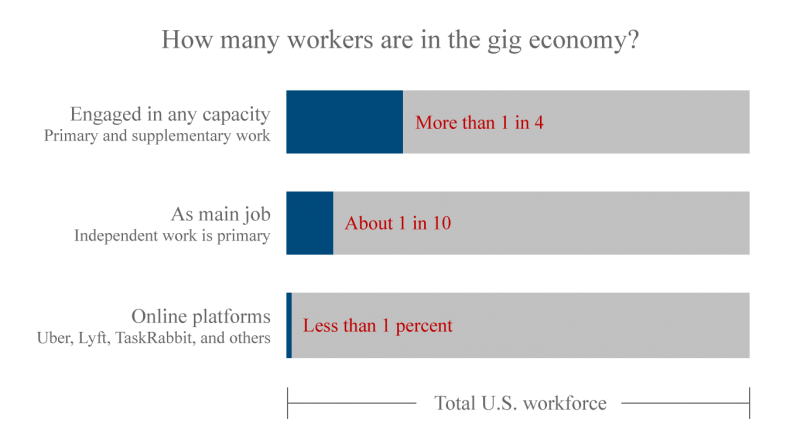There are multiple ways to estimate the size of the gig economy. Some counts include anyone who has ever done any form of non-standard work. Others look only at those who did it in the past week, or who rely only on non-standard work. Other estimates count only particular types of work, like platform-based delivery work or subcontracted jobs. Unsurprisingly, each results in different numbers. A closer examination of the similarities and differences of the definitions used in each study can be found in the Research section of the Data Hub.
More than a quarter of workers participate in the gig economy in some capacity.
Some measures of the gig economy include any worker who engages in non-standard work in any capacity—online or offline, with regular or occasional participation, and for primary or supplemental earnings. This includes workers who hold traditional full-time jobs in addition to gigs, as well as those who only do gig work.
Surveys using such a broad definition find that between 25 and 43 percent of the workforce has engaged in gig or non-standard work, including those conducted by MBO Partners, McKinsey Global Institute, and Upwork. As of 2025, that means at least 42 million people in the United States are engaged in some form of gig work. The estimates vary based on the definition of gig work used, the time frame considered, and the population included in the survey. Since large-scale public surveys, like those administered by the Bureau of Labor Statistics, tend not to ask about supplemental work, these private surveys are some of the best estimates we have of supplemental or occasional gig workers.
More than one in ten workers rely on gig work for their primary income.
Less than half of those who participate in gig work rely on gigs for their primary income. According to the Contingent Worker Supplement (CWS) administered by the Bureau of Labor Statistics (BLS), 10.2 percent of workers rely on alternative arrangements for their main job, including temp agency work, on-call work, contracted work, and freelancing. As of 2024, that percentage equates to 17.4 million people. This portion has remained stable since the last iteration of the CWS in 2017, and has decreased slightly since 2005, when 10.7 percent of the workforce relied on alternative arrangements. the last year the CWS was conducted.
Some private surveys ask about full-time gig work, and produce comparable estimates of full-time gig workers, between 10 and 13 percent of the workforce.12 Synthesizing existing studies, we estimate that those who rely entirely on gig work in order to make a living comprise less than half of all gig workers. The rest of those who take on gigs do so on a supplemental basis, in addition to part- or full-time traditional work or another income source. Further research is needed to fully understand how gig work fits into the broader labor market and how it contributes to household incomes.
- 1. The Freelancers’ Union “Freelancing in America” reports that 10.4 percent of the workforce engages in full-time independent work, using respondents’ own understandings of full-time. Edelman Intelligence, “Freelancing in America.”
- 2. MBO Partners’ “The State of Independence in America” reports that 11 percent of the workforce engages in full-time independent work, defined as more than 15 hours per week. MBO Partners, “The State of Independence.”
About one percent of workers regularly use online platforms to connect with work opportunities.
Online platforms like Uber, Lyft, and DoorDash get a lot of attention. These platforms, which connect workers with specific types of gigs, only represent a small portion of non-standard workers. Whether measured using surveys,1 tax returns,2 or bank account activity,3 roughly one percent of workers have used online platforms to arrange work in the past month. Some estimates are higher because they use a broad description of online work, and include selling goods or taking online surveys, in addition to performing services arranged online, or ask about participation over a longer period of time. In 2025, one percent of the workforce is 1.7 million people.
- 1. BLS estimates that 1.0 percent of the U.S. workforce uses online platforms to arrange work. U.S. Bureau of Labor Statistics, “Contingent and Alternative Employment Arrangements – May 2017”
- 2. Treasury Department analysis of IRS records estimate 0.7 percent of the workforce uses an online intermediary. Jackson, Emilie, Adam Looney, and Shanthi Ramnath, "The Rise of Alternative Work Arrangements: Evidence and Implications for Tax Filing and Benefit Coverage" (Washington, DC: U.S. Department of Treasury Office of Tax Analysis, 2017), https://www.treasury.gov/resource-center/tax-policy/tax-analysis/Documents/WP-114.pdf
- 3. JPMorgan Chase Institute reports 1.6 percent of adults had participated in online platforms in the past month. Farrell, Diana, Fiona Greig, and Amar Hamoudi, “The Online Platform Economy in 2018: Drivers, Workers, Sellers, and Lessors” (New York: JPMorgan Chase Institute, 2018), https://www.jpmorganchase.com/corporate/institute/document/institute-ope-2018.pdf.

Gig work requires new ways of measuring work
Many types of gig work do not fit neatly into the categories we usually use to measure the workforce. Concepts like "job" and "employer" don’t always make sense, meaning we might need new ways of asking questions in order to accurately measure non-standard workers. Some researchers have taken new approaches. For example, the Federal Reserve has asked about income-earning activities rather than jobs, since people may not describe informal sources of income as jobs. In another approach, the Internet Association measured the number of online-platform accounts held by workers, reporting 23.9 million accounts.
Each of these approaches is discussed more fully in the Data Hub's Research section, along with information on the sampling and methods of each survey. Despite some differences, across these measures, gig workers are a significant part of today’s workforce.
